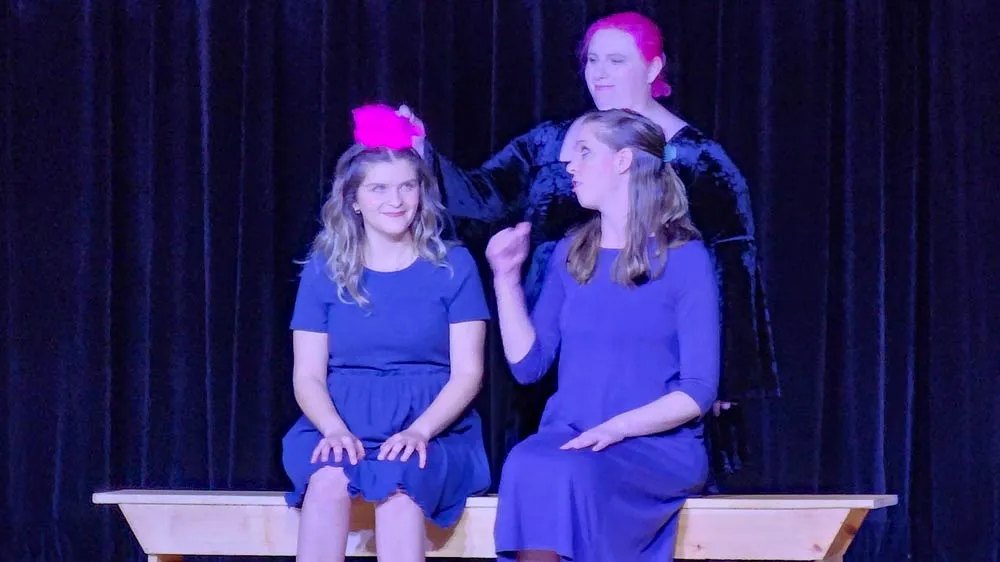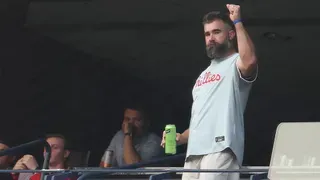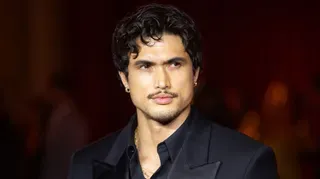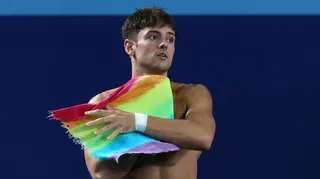December 19, 2006
Alfonso Cuar?n on "Children of Men"
Kilian Melloy READ TIME: 15 MIN.
Alfonso Cuar?n has had a successful run of movies by any measure, breaking into mainstream consciousness with the movie Y Tu Mam? Tambi?n and then following up with the third installment in the Harry Potter films, Harry Potter and the Prisoner of Azkaban. Previous to that, however, he had made several other films, including 1995's remake of the 1939 Shirley Temple film The Little Princess, and 1998's adaptation of Dickens' Great Expectations. "I only do the things that I choose to do," declares the 45-year-old filmmaker of his latest project, a movie version of P.D. James' 1993 novel Children of Men.
The book - and the new film - start with the idea of a mysterious world-wide wave of miscarriages, followed by a universal inability of women to conceive children. Clive Owen stars as Theodore Faron, a former activist who receives a plea from his ex-wife Julian (Julianne Moore), a leading figure of the underground, to meet with her. Theodore and Julian have a tragic history in common: shortly after the world's women stopped having children, a flu pandemic took the life of their young son. Their grief is still a sore spot between them, and when they meet they, like everyone else, are still reeling from the news that the youngest person on earth has been killed - at age 18 - in an accident.
As the world's population has aged with no offspring forthcoming to replace the world's final generation, anarchy has broken out and many of the planet's governments have fallen into disarray; England, always dependable in fiction of this sort to withstand earth-shattering events by resorting to iron-fisted tyranny, has become a police state - although one that attracts an unending flood of refugees from everywhere else. Figuring that Julian simply wants his help smuggling a "fugee" (short for "refugee") out of the country without allowing her to end up in a deportation camp - where violence is commonplace - Theodore consents to help Julian transport a young African woman named Kee (Claire-Hope Ashitey) to a safe house where she can await a mysterious ship called the Tomorrow. Only after Julian's small group are attacked by a band of brigands does Theodore realize that Kee is the most precious thing imaginable in this world bereft of hope: she's a pregnant woman.
"I was sent an outline of the material, and I responded to it," Cuar?n says. "The premise of infertility kept on haunting me for weeks. I remember being in Santa Barbara, on the beach, and asking myself, 'Why is this premise haunting me?' I realized that this premise could serve as a metaphor for the fading sense of hope for humanity; for humanity's lack of historical perspective, in the sense of a humanity who is completely careless of the consequences of [today's] acts on tomorrow, for the next generation. Then I realized that the premise could serve as a point of departure to try to make an exploration of the state of things today - of the things that are shaping the very first part of the 21st century. Part of the reason I did not respond to the book was I was not interested in doing a science fiction movie, so the whole departure point was to try to make a film that was about today. Two of the principle things shaping today's world are environment and immigration. Then we departed from the book - we started creating a journey that had to do more with those things, rather than with the things that the book was dealing with."
Asked about the several film adaptations of novels that he's helmed so far, Cuar?n chalks it up to the vagaries of his profession. "This thing about adaptations is true, but it's been kind of a coincidence. I've done six movies in my life: I've done two Mexican movies, two American movies, and two British movies. Except for the two Mexican movies, which are original material that I [wrote] with my brother Carlos, my movies have been adaptations. When I read the script for A Little Princess - first of all, I didn't even know it was an adaptation. I didn't even know that a Shirley Temple movie existed. I didn't learn [that] until later on. Harry Potter - that, for me, was very clear in that I had to honor a very specific universe, that it was a J. K. Rowling universe, and if I was going to do Harry Potter, I was going to put myself at the service of her material because that's such an eloquent universe that you cannot mess with it... it wouldn't only affect the movie that I was doing, but it would affect the saga - what would follow after [in subsequent movie adaptations].
"In this case," Cuar?n continues, "it was a completely different thing. I saw the premise as a point of departure. It was on that beach, as I started doing that contemplation, that the film started to unfold in front of my eyes. And then, I have to confess, I didn't even read the book. I asked Tim Sexton, my writing partner, to read the book. I said, 'I have a movie that I want to do. I don't want to second-guess the ideas that I have. I don't want to read the material - I want you to read the material.' And I am a P.D. James fan - it wasn't about it being a P.D. James book or not. It was, 'You read the book and then you bring the elements that are relevant to this movie I want to do.' And then it was, 'Okay, based upon the story that you've told me, we have all these elements that I think would be very good to incorporate in to the film.' And that was the process of adaptation."
In the book, it's Julian who gets pregnant, whereas in the movie she has a far different role to play; and Kee, who is not present in the book, must rely on Theodore to escort her through the film version's endless social and political minefields and the power-ploys on the part of those who would use her for their own aims. Kee's destination is something called The Human Project, which seems to be a secretive, isolated colony of scientists working to reverse humanity's looming extinction. Cuar?n addresses the changes he made to the characters and story, saying,"There was the obvious thing where life sprang out of Africa, as far we know; at the same time, there was a comment about the future of humanity, and I like that the future of humanity would be [embodied] by the dispossessed - Africa being the lowest of the castes of all the continents. Also," the director points out, "it was just a mathematical formula. If things are going to go really wrong, as Al Gore is telling us they are going to go - " Here, there is a burst of laughter - "then we're going to live through big periods of transformation [leading to the possibility that the] future of humanity and the renewal of our civilization will end up being in the shape of the ones [who have been] dispossessed. You see how civilizations have evolved and transformed: in practice, it's the dispossessed that take over - sometimes, absorbing the ideology of the privileged. Right now, we're in times where we need deep transformations. We need renewal - not clinging to the archaic solutions to which we've been clinging every time we attempt those renewals."
There are many things in the movie that are suggested in an visceral, rather than expository, manner; even the ending is open to interpretation, a point for which Cuar?n makes no apology. "I felt very strongly that I didn't want to make a movie that finished when the lights come on," the director says. "I wanted to make a movie that begins when the lights come on. For me, it's a film about hope, but I cannot impose a sense of hope. Hope is something very personal and internal. Yes, you can impose a sense of hope in a Hollywood ending, but that's a make-believe ending, and a hypocritical ending. I could do an ending in which you have this Caribbean island and children and Clive Owen running around surrounded by children - it was suggested. But we wanted to give just a glimpse at the possibility of hope, so audiences would make own conclusions about the possibility of hope. After witnessing a journey through what I consider the state of things, for you to make your own conclusion about hope - [about] whether, for this world, hope is a possibility - [seemed crucial to the thrust of the story]. And if there is a possibility, what do you do with that hope? For me, what is important is that what started as a personal journey [for central character Theodore] becomes his own spiritual journey. And at the end, what would be the archetype for his journey would be Moses. ... Once you regain your own sense of hope, it doesn't matter [what] the outcome [might be].
"I didn't care to take infertility literally, in the sense that I never try to explain," Cuar?n continues. "I didn't want to go in to make a movie about trying to find out [the reason], and the solution, for infertility, because [then] the movie would be about that. The Human Project was the same [kind of] thing. I didn't care to explain the Human Project because, come on, that doesn't exist [in a literal sense]. For me, the Human Project was a metaphor for the possibility of the evolution for human understanding, and the human spirit."
Cuar?n defines the core of his film adaptation by saying, "For me it was important to create a journey that was about today, and not about the future. Most of the visual references you have are from stuff that is happening today or has been happening in the last few years - not speculation about what would happen in the future. The art department, in the beginning, was frustrated: 'This is a movie about the future!' They would show me designs of buildings and cars.... they would bring me files of [designs similar to] Minority Report and all that stuff, and I would bring my file that was references and photographs from Iraq, Somalia, the Balkans, Northern Ireland, Sri Lanka, Chernobyl, the oil spills in Alaska and Mexico, and I would say, 'No, this is the movie we're doing.'"
Cuar?n's vision is thus jam-packed with topical references, instantly recognizable, that indicate how a world twenty years from now has grown directly out of today's controversies, trends, and technologies. "It was that background" that was crucial, Cuar?n insistes; "what are we trying to comment [on] throughout the film? And that was the toughest thing: what are we missing? What are we being too redundant about? I have done some time lines that I gave to the art department, so that they would understand what has happened between today and 2027. But the time line was nothing but a disguise, almost a supermarket list of things that we wanted to deal with.... I realized that it was easier for them to work from the standpoint of fiction, a standpoint from which they could understand and absorb absolutely everything. If I had just said, 'Okay, we need to deal with these themes,' it would have been something very abstract for them."
To that end, every element in every shot had to be composed just so. "Emmanuel Lubezky, my cinematographer, would say, 'We cannot afford one single frame of film that is not a comment about the state of things today.' We can, for convention of story, suggest futuristic elements: electronic billboards, or the cars [that look] a little more futuristic, but [we have to be] always putting stuff in that comments about the state of things [in the contemporary world].... we were very cautious so nothing would eliminate - emotionally, at least - the sense of the present." It's a deliberate touch that the futuristic cars look beaten up - something else that was carefully considered beforehand. "Actually, all technology that is newer than today's, is old in the movie," says Cuar?n. "But for me, there was that whole thing about not being literal. And yes, there is a literal aspect of infertility, if you want to go there - the developed nations' birth rates are dropping, while undeveloped nations birth rates are rising, and now, with this immigration phenomenon, it's changing the cultural landscape of countries when the locals are not having babies, and the immigrants are having babies. That's a parallel - for me, it was more important to view infertility as a metaphor for the lack of historical perspective, because I feel that we lead a [communal life] that is very hedonistic. We even have a hedonistic economy, an economic satisfaction of today... without any caution about the repercussions in the near future about those economic choices. We blame the corporations and the guys in power, [but] we live following that hedonistic system, and it's just because we're afraid."
The resultant look and atmosphere of the film is one of urban warfare - or, equally as striking and energetic in terms of visual style, a video-game style: motorcyle-riding killers seem to loom from a first-person perspective; at one point, as a character skitters from shelter to shelter in the midst of a frenetic street-battle, the editing takes on the cadence of a first-person shooter game: pause, observe some act of mayhem (shootings or buildings blowing up), race to the next sheltered spot, wait for the next moment of chaos to erupt, and then scamper from there to safety. "You know, I don't play video games," Cuar?n remarks; "In that sense, I'm a reactionary. I don't know how to use a computer - it's a limitation I have," the director laughs. "That whole [visual style echoes the cinematic language Lubetzky and I developed for Y Tu Mam? Tambi?n]: we thought that even if the canvas was bigger, even if the production value was bigger, the approach was going to be the same. Give the same weight to character as to social environment. That means no close-ups; you have to go wide, to blend your character with social environment. And not to use anything [in the way of] montage to try to seek an effect. The idea was to try to create the moment of truthfulness in which the camera just happened to be there, registering that moment of truthfulness. So the camera would be moving along [with] our character and his circumstances. Now," continues the director, "that is the interesting thing: a younger member of the crew, the focus puller, says, 'Wow, this is so cool, this is like a video game!' [This wasn't our intent.] According to Lubetzky and I, we were taking a photojournalistic approach. But in the end, it's good - it doesn't really matter. What matters is the emotional involvement [of the audience]. If the younger generation gets emotionally involved because of their familiarity with the video game [style], that's good, because what's important is what is beyond the shot: that moment of truthfulness."
The journalists' roundtable, by now, has gone on past the scheduled time, and the advertising agency handler is ready to drag Cuar?n out of the room to his next appointment. But the director is embroiled in the conversation and unwilling to leave just yet. He has an anecdote to share about working with Michael Caine, who plays Jasper Palmer, a friend of Theodore given to raising cannabis and listening to old Donovan records: "I met with him, and we started small talking and stuff, and he started telling me about the cool people he met with in the past. He's talking about John Lennon, and how John Lennon was his friend. As he's talking about John Lennon, I start thinking this man is just bragging about all the cool people he met. Then, toward the end of the conversation, he says, 'I'm telling you all this about John because I want to play this character as an older John Lennon.' A week later [during makeup testing], we said, 'Okay, let's take this approach.' Michael Caine gets into costume, and he has a beard and white hair and the whole thing. His wife comes in, she stands next to Michael, and she says, 'Hey guys - have you seen Michael?' That's when he started laughing, and he said, 'Okay, there you go. That's the way I'm going to play this guy.'"
Cuar?n praises the result, likening Caine's performance to a juggler's art: "You give him two balls, and he can juggle beautifully. But he comes to life when out of the blue, you start throwing him more balls. He is a machine of acting perfection - he just enjoys that challenge. I'm honored to have spent the time I spent with this guy." Cuar?n has a point: though many of the films Cane has appeared in recent years have done only middling well, commercially and critically, in this role he's transformed in ways that far exceed his make-up job, bringing a weary idealism to the role. His portrayal is, in fact, a poignant vision of a flower child in a brutal future that is unkind both to flower children and to ideals.
The intensity and deep understanding that Caine brings to his role are echoed by the rest of the cast. Cuar?n tells a story about how a car window unexpectedly shattered during an action sequence, catching Julianne Moore by surprise. "You see the reaction," Cuar?n says. "That was a real reaction of fear. You can rehearse these things [in detail], and everything's planned, but the moment you just do [it] and put all of the elements together, it becomes a moment of reality." In a later sequence of city fighting, the extras playing British soldiers became so lost in the action that they forgot the film crew was there, and knocked the camera operator off his perch. For the viewer, the immediacy of the film's visual technique meshes with the urgency of the story; the elements of story, direction, and grotty production design make this future, as a thinly disguised version of our own present time with just a little exaggeration, seem all too plausible.
In a reversal of the usual order of things, the film has opened across the world in advance of coming to American theaters. It's been well received: "I'd say the response has been fantastic," Cuar?n states. "This is one of those experiments [on the part] of the studio, because usually it's [an American release] first and Europe after. They felt so strongly about the film that they wanted to release it immediately after [its premiere in] Venice, and I've been very pleased.
"There was initially a concern that, because of the thematic [material], it was for older audiences," Cuar?n continues, "more discerning audiences. And soon what they found out is that the biggest supporter of the film has been young people. In a way, the film is a chase movie, but what young people are responding [to more than the action and adventure] is the [thematic material that the studio feared at first would alienate younger viewers]. Young people are way more concerned and aware about the stuff that we're going through than we give them credit [for]. And you know the big difference? Our generation grew up in a world that was pretty damn good. And we [have witnessed] how the place has gone to the drain in front of our eyes. And now, we feel a little guilty, a little powerless about how to find the solutions, because we're clinging to [archaic] structures, while the younger generation, they grew up in a world that was already going in the drain. So they have an instinctual impulse of transformation, and I feel that part of the problem that we're having as an older generation is, we patronize them so much. We just treat them as kids: 'You don't know the complexities of this world.' And they actually have [a greater] wisdom [then we do]. We just have to open the door to the wisdom that these [younger] guys are carrying. I believe that they are a way more evolved generation than we were - not only politically. This goes way beyond politics. [They are] going to [be responsible for] a new version of the Copernican revolution, in which we realize that we cannot solve our problems because we're seeing everything from the standpoint that [we are the center of the universe]. The young generation [know better]. I'm not saying that we're going to become [an idyllic] world in which there are hippie communes and people are swimming naked in the rivers - there are still going to be clashes. It's human nature."
Cuar?n bases this view on recent history and the social consequences that have resulted. "In the 1990s, the big [optimistic news] was that the wall in Berlin had come down; now, it's about setting [up] walls everywhere, [building] walls between Mexico and the United States, [building] walls [around] private rich communities. It's the total exclusion [of other people], and the more dangerous walls that we're building are invisible walls that people are getting used to respecting, or to fearing: people know that they don't belong there, that they cannot go over there. You don't even need to [build physical] walls. It's become about behavior, about believing certain messages: if you're this color, if you wear a turban, if you wear a suit, [you stick to your own turf]. It's become [about] little bubbles [of human experience] that are not connecting."
The movie seems to ask the question of whether human beings, having proven themselves such poor stewards of their own natural environment, might not actually deserve the specter of obliteration that haunts the production's characters. Cuar?n laughs that notion off as fatalism. "If you don't have a sense of hope, then yes, you could come to that conclusion. Nevertheless, you go through this horrible journey, and you're shown some the of the world's worst cruelty. If you have a sense of hope after that, then [what matters is] how you use your own sense of hope to make a difference - as individuals, it's like grains of sand [fighting against much larger forces]. But it's the grains of sand that make the beaches."
Like the beach Cuar?n was walking on when he first saw the dramatic possibilities for a movie that shows such a grim world, and yet finds a measure of hope? Says the director, "It's not about trying to create Utopias that are not going to happen. It's about trying to adjust [our behavior] slowly."
Kilian Melloy serves as EDGE Media Network's Associate Arts Editor and Staff Contributor. His professional memberships include the National Lesbian & Gay Journalists Association, the Boston Online Film Critics Association, The Gay and Lesbian Entertainment Critics Association, and the Boston Theater Critics Association's Elliot Norton Awards Committee.







